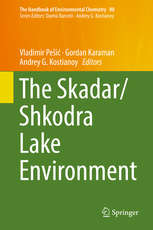Gerecke, R., Gledhill, T., Pešić, V., Smit, H. (2016) Süßwasserfauna von Mitteleuropa, Bd. 7/2-3 Chelicerata. 429 pp. Springer Berlin Heidelberg. ISBN: 978-3-8274-1893-7.

For the first time in limnofaunistic bibliography, the present taxonomic knowledge about the different clades of chelicerata having adapted to an aquatic or amphibious lifestyle along various evolutionary pathways is brought together in an overview for the Central-European fauna. A total number of 746 taxa is covered, over 99 % of these at species level.
In Volume 7/2-1 altogether 211 species are treated - 70 species of spiders, 7 species of Astigmata (3 of which to be identified only at family, genus, resp. species group level), 17 species of Oribatida, 27 species and one subspecies of Halacaridae, 45 species of terrestrial Parasitengona (4 of which to be identified only at genus level) and 45 species of Hydrachnidia (4 Stygothrombioidea, 3 Hydrovolzioidea, 16 Hydrachnoidea and 22 Eylaoidea). Volume 7/2-2 deals with 179 species of Hydrachnidia (58 Hydryphantoidea and 121 Lebertioidea).
This third volume (Volume 7/2-3) includes taxonomic keys and ecological information for 355 species of the two highly diverse Hydrachnidia superfamilies Hygrobatoidea (241 species and one subspecies) and Arrenuroidea (113 species).
The chelicerata volumes of this series are a basic tool for all limnologists interested in diversity and ecology – in particular for biologists investigating the ecotones between ground and surface water, between bottom substrata and open water, and between water and land.
Pešić, V., Karaman G., Kostianoy, A. (2018) (Eds.) Lake Skadar/Shkodra Environment. The Handbook of Environmental Chemistry, vol 80. Springer Nature, Cham 508 pp. ISBN 978-3-319-99249-5. DOI 10.1007/978-3-319-99250-1

This book reviews the unique ecosystem of the Lake Skadar/Shkodra and its basin, and discusses the latest advances made in this region to face the impact of climate change. Divided into 23 chapters, the book gathers leading expertise from various scientific and engineering communities and provides readers with extensive discussions of core issues, including the water and sediment chemistry of Lake Skadar/Shkodra and the metal pollution that is evident in plants, aquatic invertebrates and fish. Readers will discover how a sustainable science-based management approach can be applied to the Lake Skadar/Shkodra region, and will learn about the environment prospects for the region. This book is intended as an essential tool for all scientists interested in the Lake Skadar/Shkodra environment – in particular those investigating the interactions between land and water, between limnology and biota, and between natural and cultural resources.
Pešić, V., Paunović, M. & Kostianoy, A. (2020) (Eds) The Rivers of Montenegro. The Handbook of Environmental Chemistry, vol. 93. Springer Nature, Cham. ISBN: 978-3-030-55711-9. DOI : 10.1007/978-3-030-55712-6









